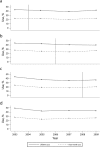Effects of state medical marijuana laws on adolescent marijuana use
- PMID: 23763418
- PMCID: PMC4007871
- DOI: 10.2105/AJPH.2012.301117
Effects of state medical marijuana laws on adolescent marijuana use
Abstract
Objectives: Medical marijuana laws (MMLs) have been suggested as a possible cause of increases in marijuana use among adolescents in the United States. We evaluated the effects of MMLs on adolescent marijuana use from 2003 through 2011.
Methods: We used data from the Youth Risk Behavior Survey and a difference-in-differences design to evaluate the effects of passage of state MMLs on adolescent marijuana use. The states examined (Montana, Rhode Island, Michigan, and Delaware) had passed MMLs at different times over a period of 8 years, ensuring that contemporaneous history was not a design confound.
Results: In 40 planned comparisons of adolescents exposed and not exposed to MMLs across states and over time, only 2 significant effects were found, an outcome expected according to chance alone. Further examination of the (nonsignificant) estimates revealed no discernible pattern suggesting an effect on either self-reported prevalence or frequency of marijuana use.
Conclusions: Our results suggest that, in the states assessed here, MMLs have not measurably affected adolescent marijuana use in the first few years after their enactment. Longer-term results, after MMLs are more fully implemented, might be different.
Figures


References
-
- Pacula RL, Chriqui JF, Reichmann DA, Terry-McElrath YM. State medical marijuana laws: understanding the laws and their limitations. J Public Health Policy. 2002;23(4):413–439. - PubMed
-
- US Department of Justice. Drug Enforcement Administration. Title 21 United States Code (USC) Controlled Substances Act. Available at: http://www.deadiversion.usdoj.gov/21cfr/21usc/index.html. Accessed February 11, 2013.
-
- Johnston LD, O’Malley PM, Bachman JG, Schulenberg JE. Monitoring the Future National Results on Adolescent Drug Use: Overview of Key Findings, 2010. Ann Arbor, MI: Institute for Social Research, University of Michigan; 2011.
-
- Gorman DM, Huber JC., Jr Do medical cannabis laws encourage cannabis use? Int J Drug Policy. 2007;18(3):160–167. - PubMed
-
- Khatapoush S, Hallfors D. “Sending the wrong message”: did medical marijuana legalization in California change attitudes about and use of marijuana? J Drug Issues. 2004;34(4):751–770.
Publication types
MeSH terms
Grants and funding
LinkOut - more resources
Full Text Sources
Other Literature Sources
Medical

